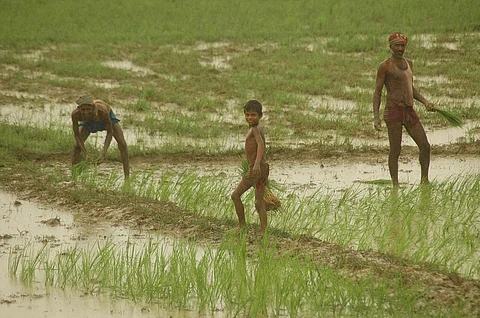

The interim report of a high-level committee constituted by the Supreme Court of India has sounded an alarm over the condition of agriculture in the country, recommending a loan waiver for farmers and the legal recognition of the Minimum Support Price (MSP) to ease the crisis.
Farmers relying solely on income from agriculture earn a meagre Rs 27 per day, according to the report. Sustaining a livelihood and maintaining a decent standard of living on such a low income is not only challenging but virtually impossible, driving them to the brink.
This stark observation was detailed in the committee’s interim report submitted to the Supreme Court on November 21, 2024. The report was prepared following the Court’s directive dated 2 November 2024. The high-level committee is chaired by retired judge Nawab Singh of the Punjab and Haryana High Court.
The committee conducted its assessment by engaging with farmers from Haryana and Punjab, many of whom have been protesting at the Shambhu border for the past year. It also examined the broader agricultural landscape.
Quoting data from the Situation Assessment of Agricultural Households and Land and Livestock Holdings of Households in Rural India, a 2018-19 national survey, the report highlighted that the average monthly income of agricultural households is only Rs 10,218, placing them at the bottom of the income pyramid in the agricultural sector.
The report further points out that stagnant production and declining incomes have left farmers heavily indebted. This escalating burden is driving many to despair and, tragically, to take their own lives.
According to a 2023 report by the National Bank for Agriculture and Rural Development (NABARD), the debt levels of farmers and agricultural labourers have surged dramatically in recent decades.
In 2022-23, institutional debt among farmers in Punjab reached Rs 73,673 crore, with Haryana’s figures even higher at Rs 76,630 crore. Additionally, the farmers bear a significant burden of non-institutional debt, which accounts for 21.3 per cent of total outstanding debt in Punjab and 32 per cent in Haryana, as per National Sample Survey Organisation (NSSO) data from 2019.
The interim report underscored the severity of the crisis, calling the rising debt an “ever-increasing crisis.” The committee revealed that over 400,000 farmers and agricultural labourers have died by suicide in the past three decades, a grim testament to the escalating challenges faced by the sector.
“In India, more than 400,000 farmers and farm workers have committed suicides since 1995 when the National Crime Record Bureau began collecting the data. In Punjab, a house-to-house survey conducted by three public sector universities recorded a total of 16,606 suicides among farmers and farm workers in 15 years, between 2000 and 2015,” the committee stated in its interim report.
The report delved into the causes behind this crisis, tracing its roots to the stagnation in agricultural production and yields following the initial gains of the Green Revolution in the mid-1990s. Simultaneously, the debt burden on farmers and agricultural labourers has multiplied in recent years.
Declining agricultural incomes, rising production costs and shrinking employment opportunities have exacerbated the crisis, disproportionately impacting small and marginal farmers and agricultural labourers.
“At the national level, 46 per cent of total workers are absorbed in agriculture whose share in income is only 15 per cent,” the report noted. “Not only this, there is a very high rate of disguised unemployment and a large number of unpaid family workers. A significant proportion among them is working poor.”
Between 2014-15 and 2022-23, Punjab’s agriculture sector ranked 20th out of 21 major agricultural states, with an annual growth rate of merely 2 per cent. Haryana fared slightly better, ranking 16th with a growth rate of 3.38 per cent. Both states have consistently underperformed compared to the national average.
The report also highlighted the adverse effects of climate change and environmental degradation on agriculture. Declining water tables, droughts, excessive rainfall, hot winds and the challenges of managing crop residues have all weakened the sector further, threatening food security.
“This (crisis) comes at a time when it has been conclusively established that agricultural growth and sustainability has far more potential to alleviate poverty and provide livelihood to significantly large sections of the population,” the report stated. “Concrete steps are urgently needed to reform the agricultural sector and make it profitable.”
The committee has emphasised key recommendations, including granting legal recognition to the MSP, implementing measures for debt relief and fostering employment generation, in its interim report.
Additionally, it has called for the promotion of organic farming and crop diversification, alongside reforms to improve the agricultural marketing system.